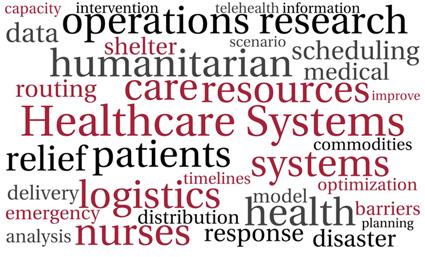Department of Industrial Engineering
4207 Bell Engineering Center
1 University of Arkansas
Fayetteville, AR 72701
Phone: (479) 575-3156
Fax: (479) 575-8431
Home Health Industry and Nurse Routing
How should home health nurses be routed
to visit a set of patients in their homes?
How should user-generated data be considered
during disaster relief decision making?
 Assistant Professor Ashlea Bennett Milburn conducts research in the areas of health
and humanitarian systems (HHS) and logistics systems (LS) by adapting and applying
operations research (OR) tools and techniques to problems arising in these fields.
Assistant Professor Ashlea Bennett Milburn conducts research in the areas of health
and humanitarian systems (HHS) and logistics systems (LS) by adapting and applying
operations research (OR) tools and techniques to problems arising in these fields.
Much of her work in health systems has focused on the home health care industry which is a critically important and growing sector of the U.S. health care continuum, serving over 12 million homebound patients in 2010 alone. When utilized in partnership with other treatment components, home health care can improve patient outcomes, reduce total cost of a treatment episode and reduce hospitalizations. However, the benefits of home health care can only be realized if patients have access to these services. It is estimated that by 2020, there will be 400,000 fewer nurses than needed. Therefore, her research addresses the effective utilization of key resources and ensuring the supply of services in a geographic region is sufficient to meet demand in that area. For example, it is estimated that home health nurses in the US drive 5 billion miles per year – double the amount driven by UPS drivers worldwide. Developing models and solution approaches for more efficient home health nurse scheduling and routing will significantly increase the amount of time that can be devoted to direct patient care.
In addition to home health systems, Dr. Milburn also performs research in the area of humanitarian logistics focused on disaster response. Over 6,900 disasters were reported during the ten-year period from 2002 to 2011, causing over 1.2 million total deaths and affecting almost 2.7 billion people. Major relief organizations such as the International Federation of Red Cross and Red Crescent Societies recognize the critical roles of logistics and the optimized use of scarce resources in saving lives in disasters, as impacted populations are left in need of food, water, shelter, and medical attention, among other things. The Federal Emergency Management Association (FEMA) describes three primary methods of issuing such supplies after a disaster. Using mobile delivery, vehicles deliver supplies directly to drop locations and points where needs have been identified. Using direct delivery, supplies are delivered to a specific location such as a shelter or hospital. Lastly, in the Points of Distribution (POD) method, commodities are delivered to centralized points (i.e., PODs) and impacted populations come to the PODs to retrieve supplies. Dr. Milburn is researching how user-generated data impacts response plans for both mobile delivery and POD methods of issuing supplies.
 Social media usage during emergencies is accelerating the pace at which information
becomes available to emergency managers. In fact, three-quarters of emergency agencies
participating in a 2012 survey conducted by CNA Analysis & Solutions and The National
Emergency Management Association (NEMA) indicated their agencies rely in some capacity
on social media for information. However, concerns regarding the accuracy of social
data constitute a barrier to its usage. Because the data is user-generated and it
is initially not verified, a majority of respondents indicate that their agency would
take action on social data only after verifying it. However, not all social data is
inaccurate, and waiting to take action until it is verified contradicts one of its
primary advantages – timeliness. Dr. Milburn’s research analyzes the tradeoff by developing
frameworks to assess whether there is value in acting on user-generated data prior
to its absolute verification in the context of mobile delivery and POD location decisions.
Social media usage during emergencies is accelerating the pace at which information
becomes available to emergency managers. In fact, three-quarters of emergency agencies
participating in a 2012 survey conducted by CNA Analysis & Solutions and The National
Emergency Management Association (NEMA) indicated their agencies rely in some capacity
on social media for information. However, concerns regarding the accuracy of social
data constitute a barrier to its usage. Because the data is user-generated and it
is initially not verified, a majority of respondents indicate that their agency would
take action on social data only after verifying it. However, not all social data is
inaccurate, and waiting to take action until it is verified contradicts one of its
primary advantages – timeliness. Dr. Milburn’s research analyzes the tradeoff by developing
frameworks to assess whether there is value in acting on user-generated data prior
to its absolute verification in the context of mobile delivery and POD location decisions.
In a new research effort, Dr. Milburn’s two focus areas intersect. In November 2014 she was awarded a Provost’s Collaborative Research Grant at the University of Arkansas to collaborate with a faculty member in the UA Eleanor Mann School of Nursing to study the surge capacity of home health during public health emergencies. Surge capacity is defined as the ability of the health system to expand in order to quickly meet increased demand in the event of a large-scale public health emergency. The project uniquely combines two of her primary research thrusts – home health care and disaster response planning. While the motivating scenario for their preliminary project is pandemic influenza, the researchers plan to generalize the model to wider disease scenarios and to determine interventions for improving response and potentially increasing surge capacity. They would also like to study how telehealth, through enabling simultaneous monitoring of several patients from a distance, can improve the effectiveness of response efforts and prevent disease spread.
